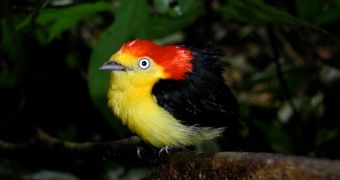Each year before the mating season, birds called wire-tailed manakins gather in groups called leks. These are basically groups of competitors, which fight against each other for the females of the species. But within these groups, some of the males are in fact cooperating, researchers found.
In a recent study, they analyzed the behavior of numerous males in such leks, and made the interesting discovery. These birds, native residents of tropical forests in the Americas, are apparently able to put their differences aside for a little while.
Their cooperation takes on the form of creating allegiances and smaller groups, whose roles is to help their members achieve a common cause. Details of the new work appear in a recent issue of the esteemed journal Behavioral Ecology.
Experts managed to secure funds from the National Science Foundation (NSF) for this investigation, which sought to make sense of the long-term behaviors of manakin leks. The most important conclusion was that some of the birds appear to coordinate their courtship displays.
“Male vertebrates often form reproductive coalitions to gain access to or to defend females, and in most contexts they compete for those females,” explains research scientist Brandt Ryder, who is based at the Smithsonian Conservation Biology Institute (SCBI), in Washington, DC.
As for the coordination male manakins exhibit, the expert says that “these displays, and the resulting leks formed, are a rare example of male cooperation within a lek social system.” This behavior can be seen in both wire-tailed and blue-backed manakin groups.
Experts say that the behavior is more likely to have evolved twice than to have been transmitted between the two species. Instances of the same natural processes evolving in several directions at once, or in different animal species, are not unheard of.
“These display coalitions have long been of interest to scientists from an evolutionary standpoint, because of the paradox of apparent cooperative behavior in a situation with intense competition,” says Bette Loiselle, a researcher at the NSF Division of Environmental Biology.
The expert also holds an appointment at the University of Florida. She conducted the long-term manakin study together with Ryder and UF colleague John Blake.

 14 DAY TRIAL //
14 DAY TRIAL //